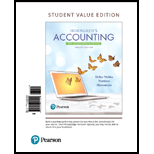
Concept introduction:
Classification of Investments:
The investments are classified on the basis of the two factors to be considered –
1. Intent of the company
2. Length of time for which it will be held.
The three categories for investments are –
i. Trading investments
The debt and equity securities investments will be classified as trading securities if they are purchased with an intention to be sold in a short time of their purchase. Suppose, 3 months or 4 months i.e. held with an intention to be sold in a short period.
ii. Available-for-sale investments
The debt and equity securities investments will be classified as available-for-sale investments if they are purchased with an intention to be sold in a longer time period say, more than a year. By default all the investments are classified as available-for-sale investments.
iii. Held-to-Maturity
Held-to-maturity investments are the investments that are purchased with an intention to be held till maturity. When a purchase is made with an intent that it will be held till maturity, it will be classified as held-to-maturity investment.
How the investment will be classified.
Explanation of Solution
The correct answer to the question will be –
b. No significant influence equity investment
This can be explained as, it is given in the question that the investment represents 5 % of the voting stock and it will be held for three months, thus it is satisfying the conditions for trading investments. The trading investments do not have significant influence equity investment as it represents 5 % of the voting stock,
Thus, No significant influence equity investment or trading investment is the correct option for the given situation.
The other options can be discussed as under –
Option a, significant influence equity investment –
Significant influence investments are the investment when the voting stock purchased is more than 20%. But in the given situation only 5 % of the voting stock has been purchased.
Option c, held-to-maturity investments –
As discussed above, held-to-maturity investments are the investments that are purchased with an intention to be held till maturity. When a purchase is made with an intent that it will be held till maturity, it will be classified as held-to-maturity investment
In the given situation the investment is purchased with be sold within a period of 3 months. Thus, this is also an incorrect option.
Option d, controlling interest equity investment
When the voting stock purchased is more than 50 %, it will be treated as controlling interest equity investment. It is given in the question that the investment represents 5 % of the voting stock, thus, this option will also be treated as incorrect choice.
Thus, from the above discussion it can be concluded that, the correct option will be b. No significant equity investment or trading investment as it will sold within a period of three months.
Want to see more full solutions like this?
Chapter 15 Solutions
Horngren's Accounting: The Managerial Chapters, Student Value Edition (12th Edition)
- Nonearrow_forwardIndira Products has provided the following data for the month of August: a. The balance in the Finished Goods inventory account at the beginning of the month was $65,000 and at the end of the month was $29,500. b. The cost of goods manufactured for the month was $210,000. c. The actual manufacturing overhead cost incurred was $71,800 and the manufacturing overhead cost applied to Work in Process was $75,200. d. The company closes out any underapplied or overapplied manufacturing overhead to the cost of goods sold. What is the adjusted cost of goods sold that would appear on the income statement for August?arrow_forwardLand should be capitalized at what amountarrow_forward
- Delta Tools estimated its manufacturing overhead for the year to be $875,500. At the end of the year, actual direct labor hours were 49,600 hours, and the actual manufacturing overhead was $948,000. Manufacturing overhead for the year was overapplied by $81,400. If the predetermined overhead rate is based on direct labor hours, then the estimated direct labor hours at the beginning of the year used in the predetermined overhead rate must have been _.arrow_forwardWhat is the depreciation expense for 2022arrow_forwardCan you solve this financial accounting question with the appropriate financial analysis techniques?arrow_forward
- Julius provided consulting services amounting to P420, 000. His total expenses were 25%. His net income is: A. P105,000 B. P300,000 C. P315,000 D. P120,000arrow_forwardWhat is the cost of goods soldarrow_forwardSnapGallery Inc. sells one digital poster frame. The sales price per unit is $12. The variable cost per unit is $7. Fixed costs per annum are $13,500 and having a sales volume of 5,000 digital poster frames would result in: 1. a profit of $11,500 2. a loss of $2,500 3. breaking even 4. a profit of $8,000arrow_forward

 AccountingAccountingISBN:9781337272094Author:WARREN, Carl S., Reeve, James M., Duchac, Jonathan E.Publisher:Cengage Learning,
AccountingAccountingISBN:9781337272094Author:WARREN, Carl S., Reeve, James M., Duchac, Jonathan E.Publisher:Cengage Learning, Accounting Information SystemsAccountingISBN:9781337619202Author:Hall, James A.Publisher:Cengage Learning,
Accounting Information SystemsAccountingISBN:9781337619202Author:Hall, James A.Publisher:Cengage Learning, Horngren's Cost Accounting: A Managerial Emphasis...AccountingISBN:9780134475585Author:Srikant M. Datar, Madhav V. RajanPublisher:PEARSON
Horngren's Cost Accounting: A Managerial Emphasis...AccountingISBN:9780134475585Author:Srikant M. Datar, Madhav V. RajanPublisher:PEARSON Intermediate AccountingAccountingISBN:9781259722660Author:J. David Spiceland, Mark W. Nelson, Wayne M ThomasPublisher:McGraw-Hill Education
Intermediate AccountingAccountingISBN:9781259722660Author:J. David Spiceland, Mark W. Nelson, Wayne M ThomasPublisher:McGraw-Hill Education Financial and Managerial AccountingAccountingISBN:9781259726705Author:John J Wild, Ken W. Shaw, Barbara Chiappetta Fundamental Accounting PrinciplesPublisher:McGraw-Hill Education
Financial and Managerial AccountingAccountingISBN:9781259726705Author:John J Wild, Ken W. Shaw, Barbara Chiappetta Fundamental Accounting PrinciplesPublisher:McGraw-Hill Education





